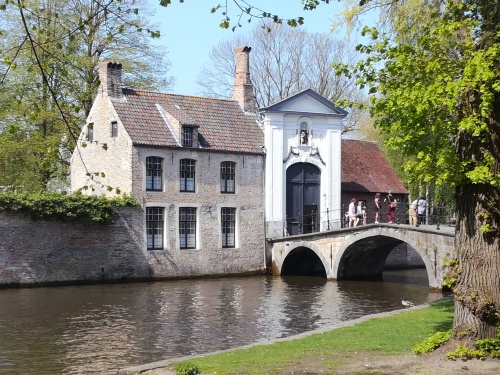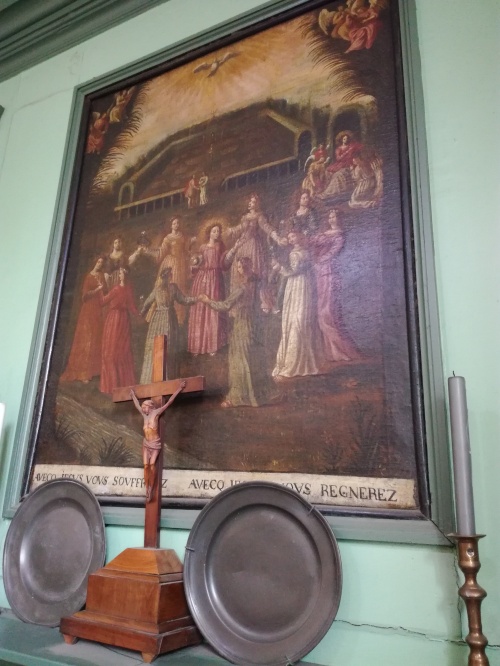Let’s find out! I visited Bruges recently and share some of my photos below.

The beguinage at Bruges (Belgium)
The 12th and 13th centuries were characterized by renewed religious fervor. New spiritual pathways emerged. Some of them were seen as heretical (like the Cathars), while others were tolerated. Franciscans and Dominicans came into existence to reorder the Church from the inside out. The beguines emerged as one of the most original spiritual pathways and they endured for hundreds of years. They can also be viewed as the first feminists.
The beguines appeared at the end of the 12th century. These women initially came from the poorer classes and sought a life of faith without taking formal vows. At first, small groups located themselves in urban settings near hospitals or abbeys. They dedicated themselves to prayer and contemplation, but worked in their communities caring for the sick. The beguines were a conundrum and a challenge to the social order. Free from the male dominance of a husband or spiritual director, the beguine was an independent entity. Her freedom also required she support herself by working. This beguine structure for the first time opened a religious path for poor women who previously had no access to it. Nuns came from wealthy classes and bought their way into the life through large dowries, impossible for poor women.

There is controversy over where the first beguine community was, but we know the movement spread quickly from Flanders through Italy, France, Poland, and Hungry. Over time a communal lifestyle prevailed and took hold. The beguines lived in a beguinage that functioned as a predominantly independent community, with rights and the ability to own property. Women often sought work in the thriving textile industries of their cities. By 1240, most of the beguines in the south of Flanders were living in communities surrounded by walls, where the door was closed at night creating its own version of a monastic center. The beguines had no founder and adopted no universal rule. There was no central authority. Each beguinage was a separately functioning entity, and this was sometimes a strength and sometimes a weakness.

Not surprisingly, beguine communities were the subject of much concern for the Church. The movement ran counter to the power structure and heresy was often a concern, but two papal bulls in the 13th century did support the movement. But it was not enough. Some beguines were burned for heresy while others received protection. By the 14th century, the beguines were suffering. They were subject to inquisitional authorities, and some beguinages closed losing their assets while others were absorbed into traditional monastic orders. Some beguinages persisted through the Protestant Reformation and the French Revolution, but only a few survived into the 20th century. These were clustered in Belgium including the one at Bruges.
I’ve been to several former beguinages in the Low Countries now. They are always peaceful, contemplative places. From these places, there are still echoes of women wanting spiritual space and a place in the world. Sauve Garde.

Read more:
The Beguines:Women in Search of Sanctity Within Freedom -Silvana Panciera
The Wisdom of the Beguines- Laura Swan
Meister Eckhart and the Beguine Mystics– Bernard McGinn
Owl Killers– Karen Maitland (fiction), starts and ends at the Bruges beguinage
Sisters Between-Molly Connally (fiction)








Fascinating! I had no idea that beguines were people– or that only wealthy women could become nuns, despite going to school for 12 years with teachers from the Sisters of the Humility of Mary, an order founded by upper-class girls from France.
The attacks by the church hierarchy against the beguines have been echoed in recent years by bishops going after orders of nuns who were considered a bit too independent for the old men’s tastes.
LikeLike
Women have always walked a tightrope trying to exist in the patriarchy. And still do.
LikeLike
Thanks for this post. You’ve introduced me to a term I didn’t know until now. Lovely pictures, too!
LikeLike
Thanks!
LikeLike
So intriguing and beautiful!
LikeLike
Wonderful and interesting post. The photos are excellent. Thank you.
LikeLike
Interesting to know that!
LikeLike
Fascinating! Lovely photos, too!
LikeLiked by 1 person
Very cool stuff – I’ve never heard of a Beguine. Thanks for posting. The pictures are beautiful!
LikeLiked by 1 person
LOVE the beguines, and just the whole miracle of that movement at a time of utter patrimony. Some notable beguines even became the spiritual directors of priests who sought them out. In some places this was acceptable to the bishops, but often it was not. The priests did it anyway. Amazing times! In Laura Swan’s book, I believe she says that they were often funded by wealthy women? Thanks for the wonderful pix, Ellis, and a reminder of these phenomenal women!
LikeLike
Because each was unique, there were apparently some beguinages who had mostly rich women. Others (usually the bigger ones) were open to all classes. What’s also impressive is how fast the movement caught on and the sheer numbers involved. Basically every town in the low countries had at least one and the cities had multiple beguinages. Some had ranks in the hundreds and maybe a thousand.
LikeLike
I’m pretty obsessed with them. Definitely our mystical forebears.
LikeLiked by 1 person
inspiring. thank you.
LikeLiked by 1 person
Interesting. Thank you.
LikeLike
This was so interesting. I knew about the Cathars. Thank you, Ellis.
LikeLike
I’ve written a Cathar book and am looking for a publisher for it. It’s YA visionary fiction. Anyway- we will be traveling into the Langduedoc soon and visiting the burning fields at Montsegur.
LikeLike